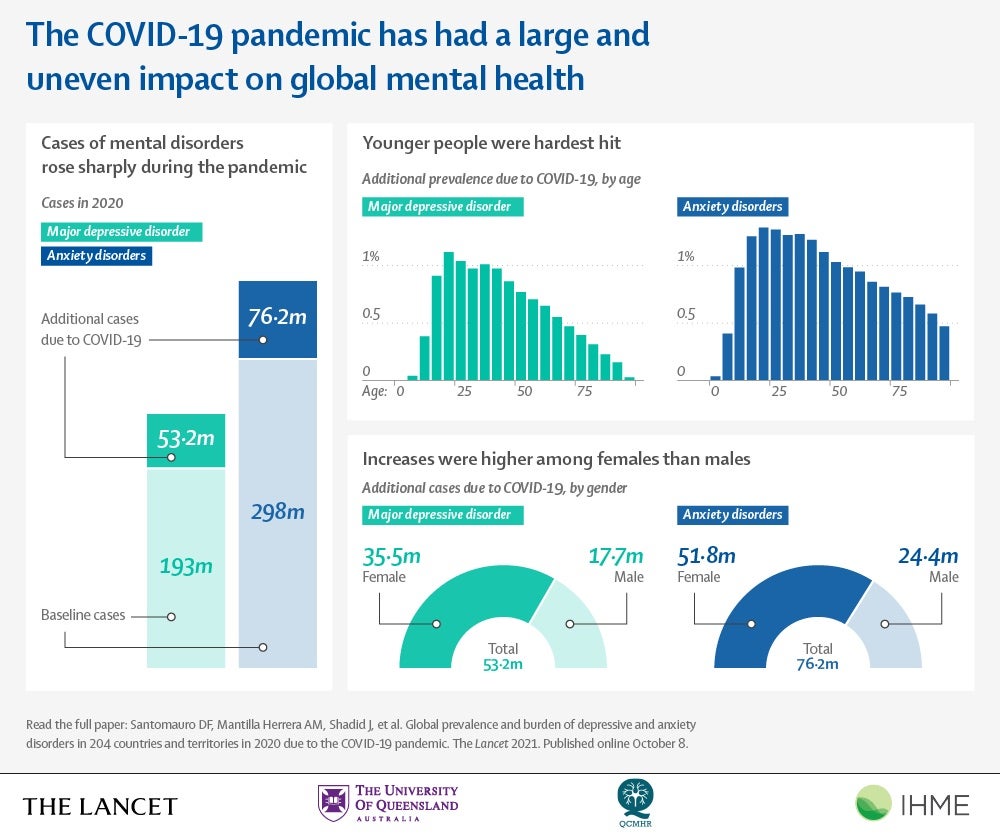COVID has posed a threat to body—and mind—for all people on the planet—the essence of the Greek-rooted coupling of πᾶν (pan) plus δῆμος (demos) to form the now too-familiar noun.
Yet there has been no incisive examination to date of the pandemic’s psychological toll on a global basis. It is difficult to determine increases in cases of depression and anxiety because of a lack of data. No good numbers exist for many countries and even whole continents (Africa and South America).
Despite gaps in the data, a team largely based at the University of Queensland in Australia has made an estimate for 2020. “This study is the first to quantify the prevalence and burden of depressive and anxiety disorders by age, sex, and location globally,” the researchers wrote in the Lancet.
The numbers themselves are devastating. Cases for depressive and anxiety disorders last year are estimated to have increased by more than a quarter—an unusually large surge.
If the pandemic had not happened, the model used by the researchers estimated there would have been 193 million cases of major depressive disorder worldwide, whereas an estimated 246 million cases actually occurred, a 28 percent increase, or an added 53 million cases. For anxiety disorders the number of cases was anticipated at 298 million, but there may have been an actual 374 million cases—a 26 percent jump, representing an added 76 million cases.
The figures for both depression and anxiety usually remain stable from year to year. Such sharp upturns cannot be counted as routine fluctuations;“This is definitely like a shock to the system from what we are typically used to seeing when it comes to the prevalence of these disorders,” says Damian Santomauro, the lead author, from the Queensland Center for Mental Health Research, School of Public Health at University of Queensland.

Women and young people were hit particularly hard. Almost 52 million of the added cases for anxiety during the first COVID year were accounted for among women, contrasted with 24 million for men. Although COVID caused more death and serious illness among older people, it was younger people who faced the greatest burdens of depression and anxiety. The category with the highest burden—the 20- to 24-year age bracket—had an estimated 1,118 added depression cases per 100,000 people, and 1,331 more per 100,000 for anxiety. “We are hoping that these findings encourage more dialogue by policy makers, governments, researchers and people considering resource allocation and planning for mental health responses,” says Alize Ferrari, one of the University of Queensland researchers.
The university team succeeded in making an estimate for global levels of depressive and anxiety disorders by compensating for the data that were lacking. They did so by relying on other data put together from 48 studies conducted in Western Europe, parts of North America, Australasia and other regions that actually had mental health figures. They were able to statistically link depression and anxiety data to “COVID-19 impact indicators,” infection rates by country and indicators tracking diminished population movements for 204 countries. That statistical relationship between impact indicators and mental health data, analyzed for North America and other regions, could then be used to extrapolate the missing estimates for depressive and anxiety disorders for the many countries that lacked that data. All that was needed to make the calculations was the impact indicators, which exist for almost every nation.
Maxime Taquet, an academic clinical fellow in the department of psychiatry at the University of Oxford, who was not involved with the study, praised the effort as providing the first insight into the global impact of the pandemic on mental health. The study, he says, also points to the urgent need for depression and anxiety statistics from the countries for which estimates could only be made with statistical extrapolations. “We need to be quite cautious when we interpret the findings of this study because in large areas of the world we simply don't have any data,” he says. Taquet wrote a commentary for the Lancet about the study.
The study will continue until the pandemic ends. The data are being incorporated in the larger Global Burden of Disease study, led by the Institute for Health Metrics and Evaluation (IHME) at the University of Washington. Those numbers will surely be useful. COVID’s mental health consequences are sure to linger long after any unofficial declaration that the pandemic has come to a close.


